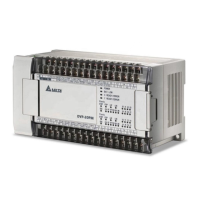3 Devices
DVP-20PM Application Manual
3-41
Bit# Description
13
Bit 13=0: The calculation of the target position of the axis is triggered by a
transition in DOG’s signal from low to high.
Bit 13=1: The calculation of the target position of the axis is triggered by a
transition in DOG’s signal from high to low.
(The setting of bit 13 is applicable to the insertion of single-speed motion, and the
insertion of two-speed motion.)
14
Bit 14=0: Trapezoid curve
Bit 14=1: S curve
Setting the
noncyclic
1. D1832: Setting the number of times noncyclic elec
tronic cam motion is repeated
elect
ronic cam
D1832, D1833,
and D1834
Only DVP-20PM series motion controllers support this function.
Users can set the number of times noncyclic electronic cam motion is repeated
by means of D1832. If the value in D1832 is greater than H8000 (bit 15=1), there
will be cyclic electronic cam motion. If the value in D1832 is 0, noncyclic
electronic cam motion will not be repeated. If the value in D1832 is 1, noncyclic
electronic cam motion will be repeated once.
D1832=0
D1832=1
2. D1833: Number of remaining pulses sent by the master axis of an electronic cam
If the number of pulses sent by the master axis of an electronic cam is not
divisible by the number of pulses per ccycle, users can divide the number that is
left by setting D1833. If the number of pulses sent by the master axis of an
electronic cam is 202, and the number of pulses per cycle is 50, two pulses will
be left after four cycles. If the value in D1832 is 3, and the value in D1833 is 2,
one pulse will be added to the first cycle and the second cycle.
D1832=4 and D1833=1
D1832=4 and D1833=3
*The value in D1833 can not be greater than the value in D1832.

